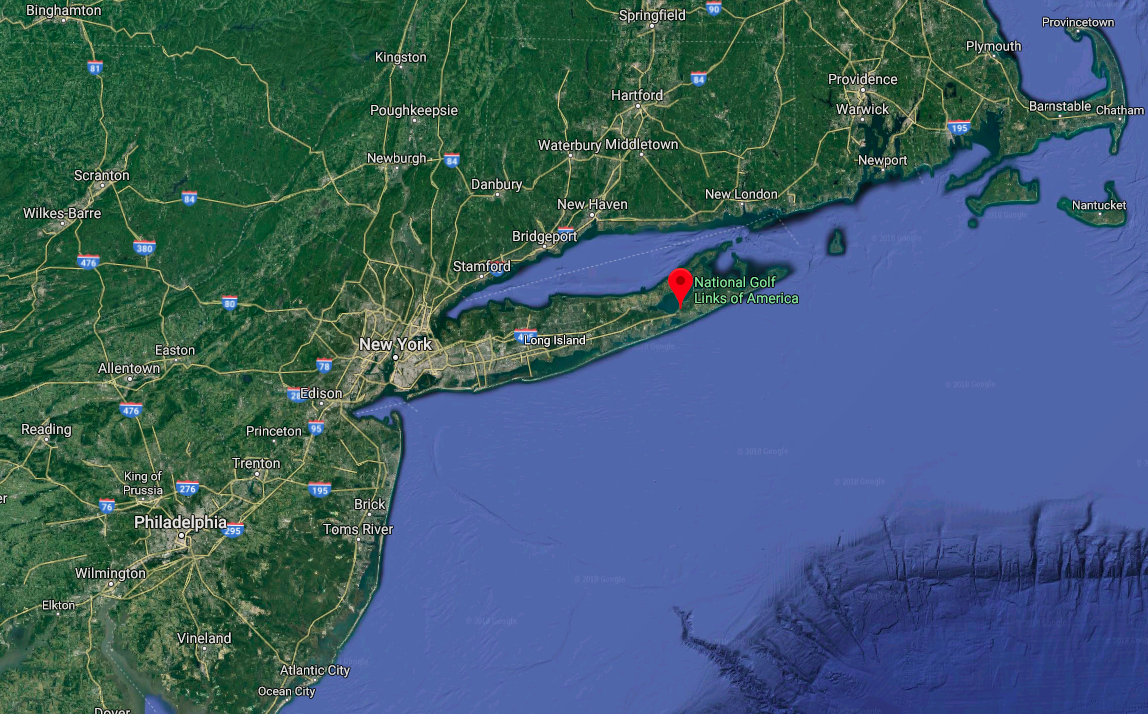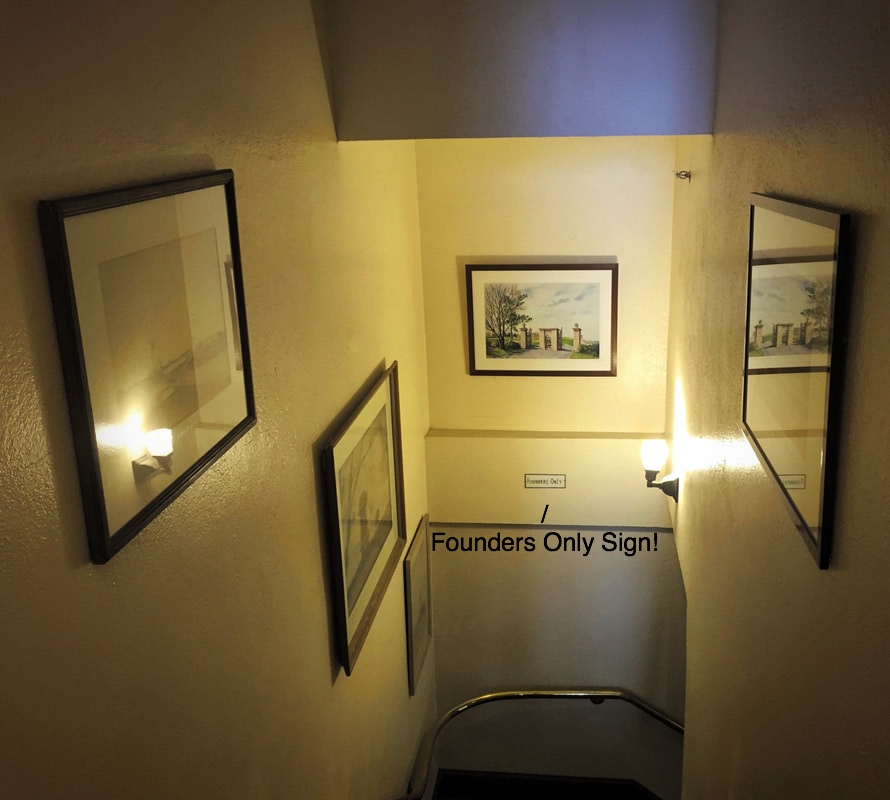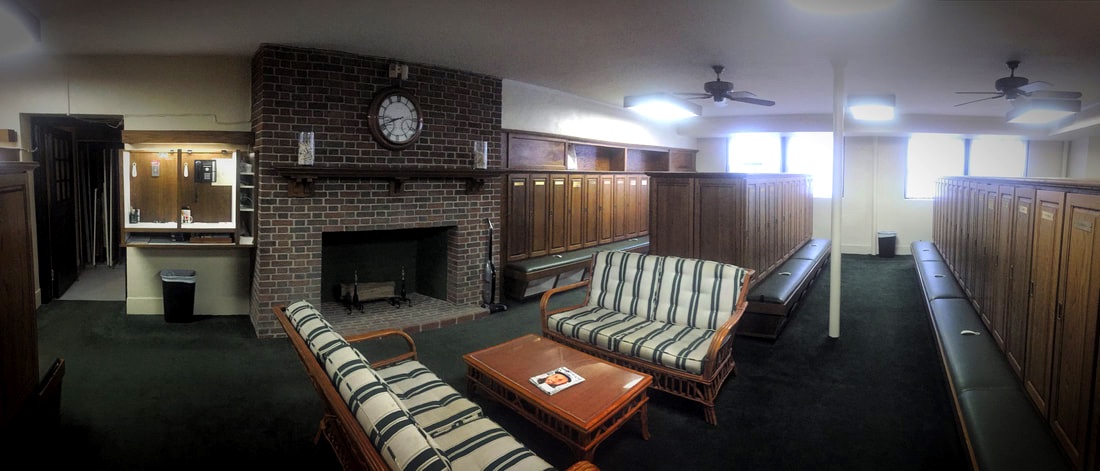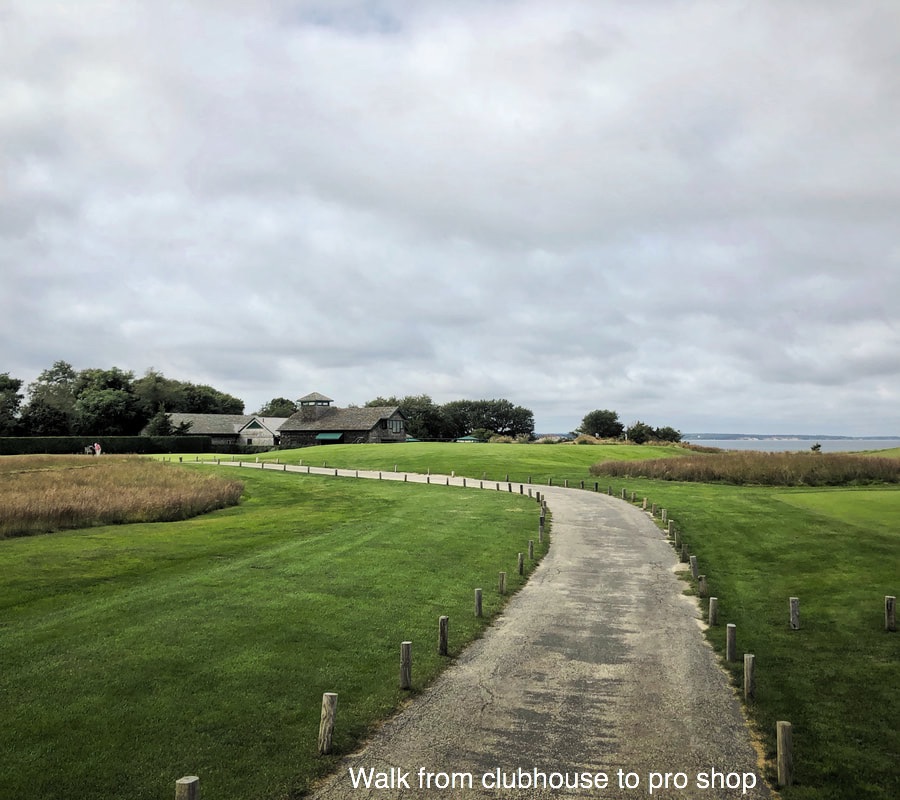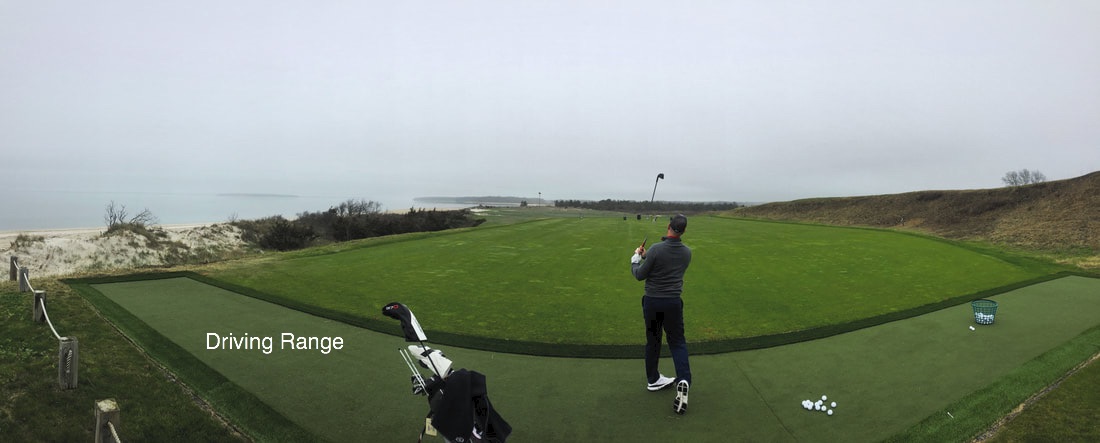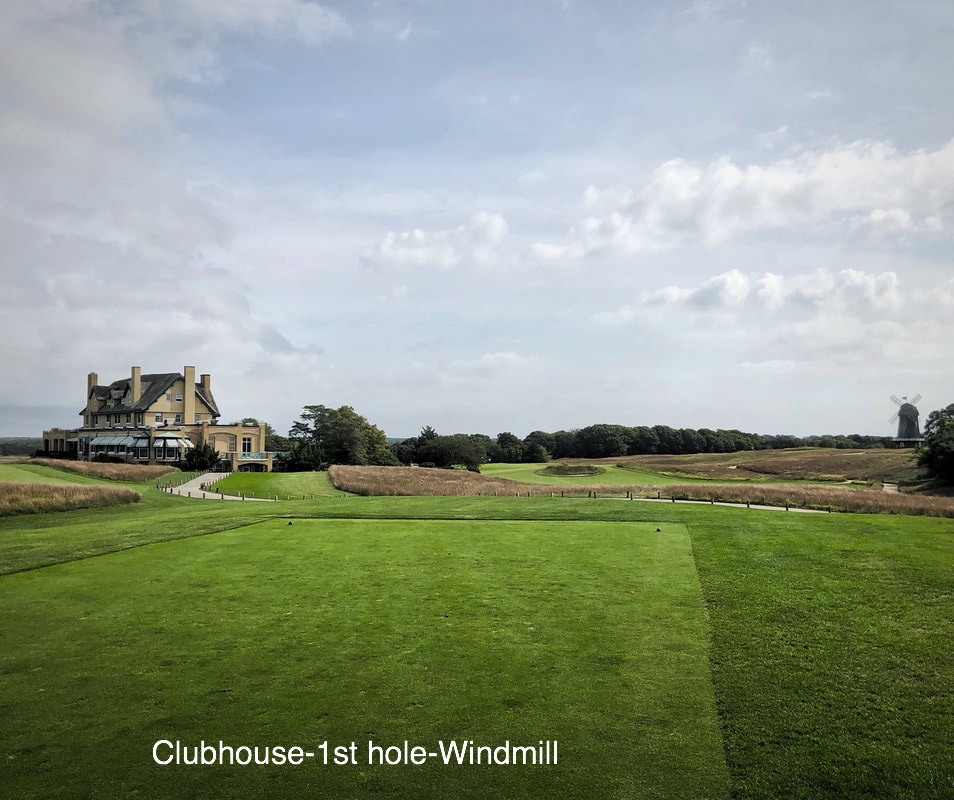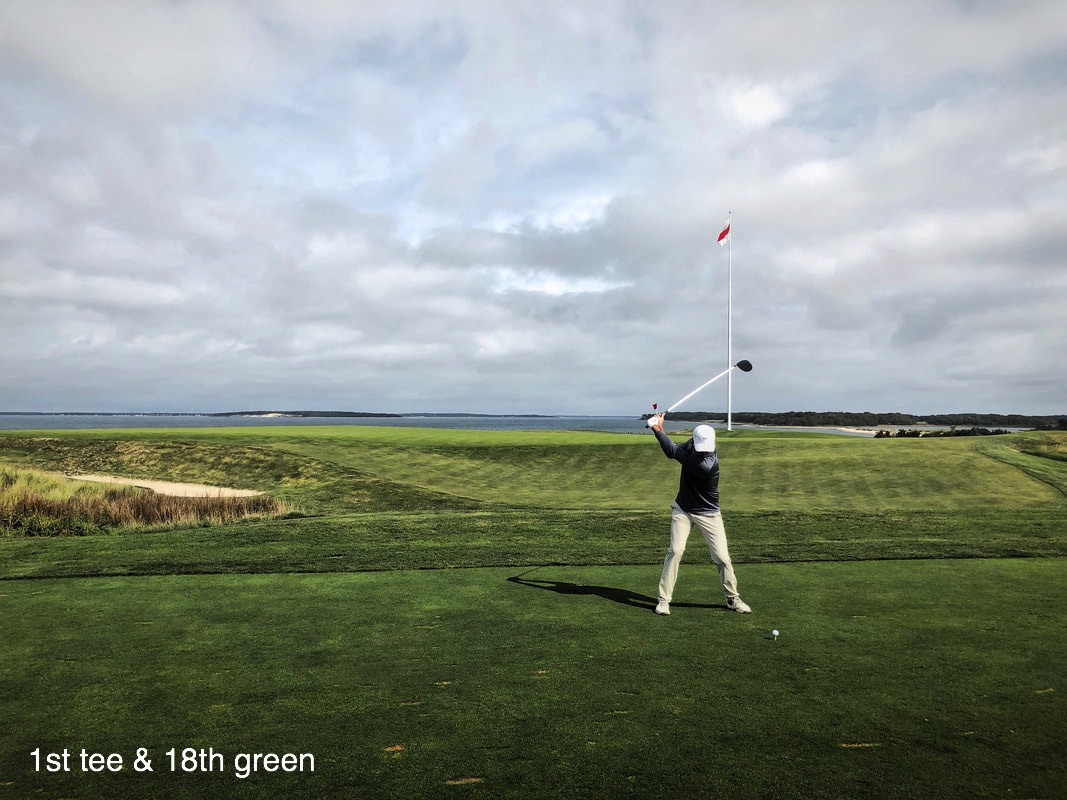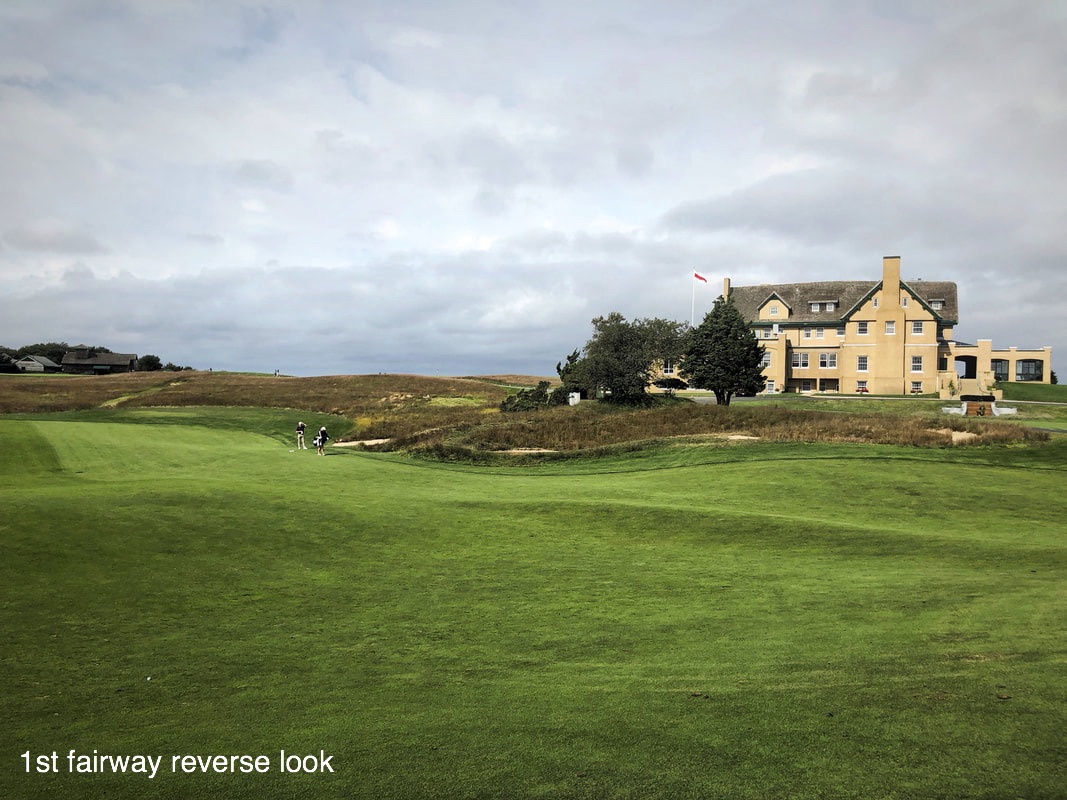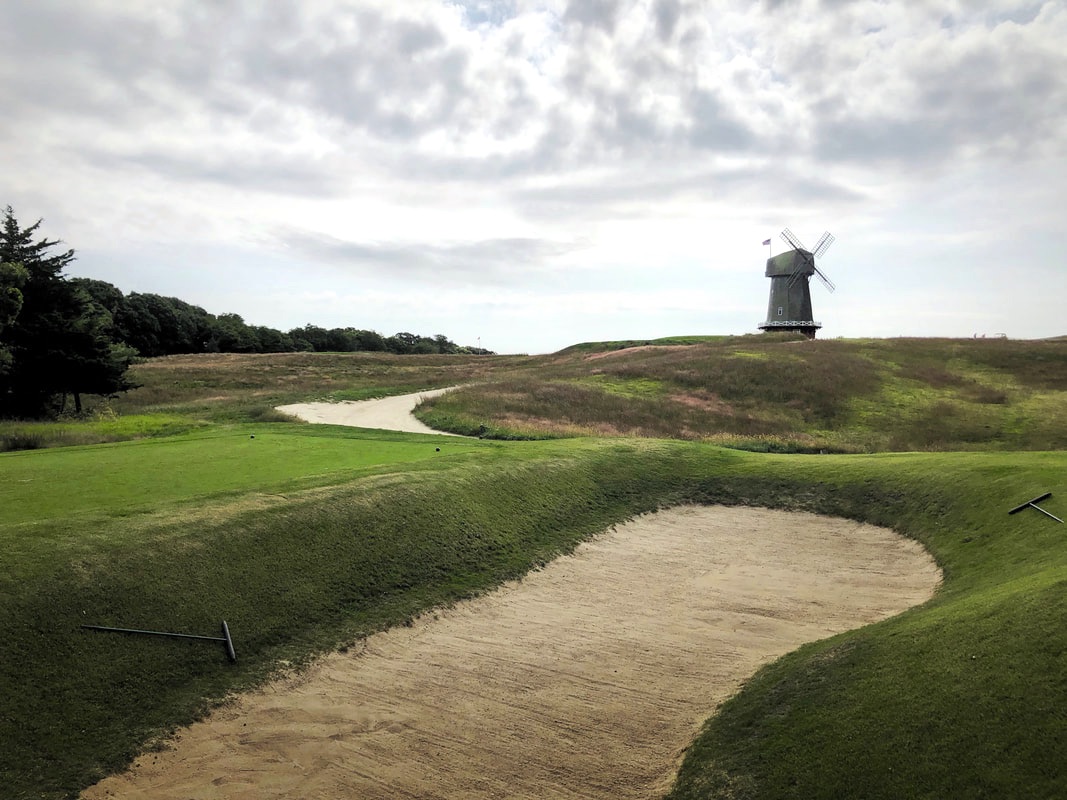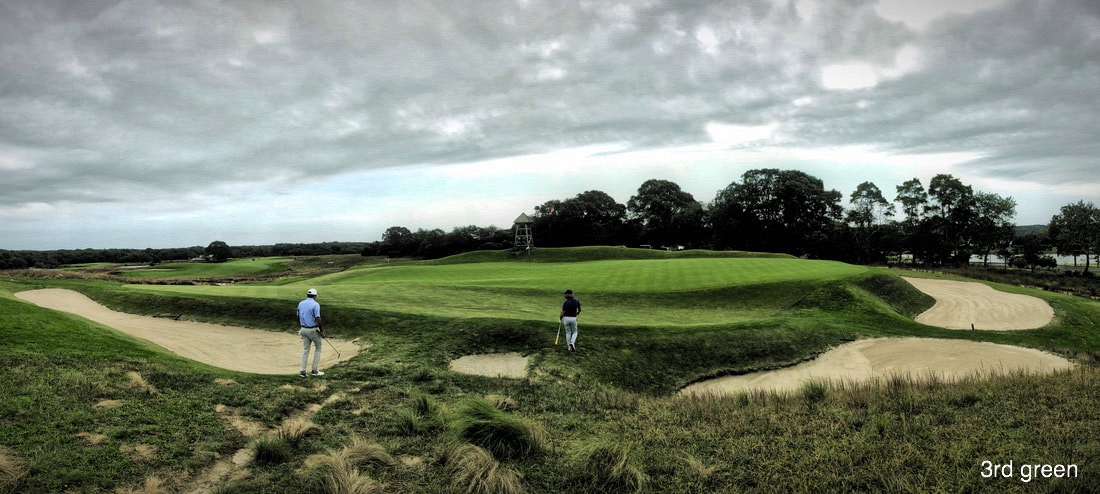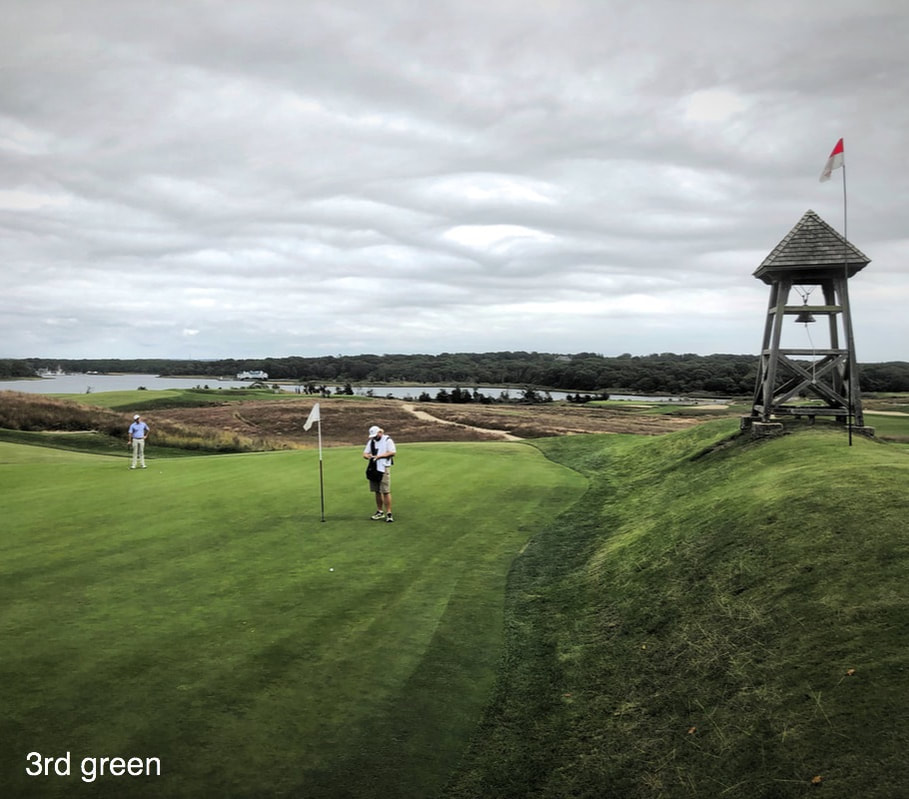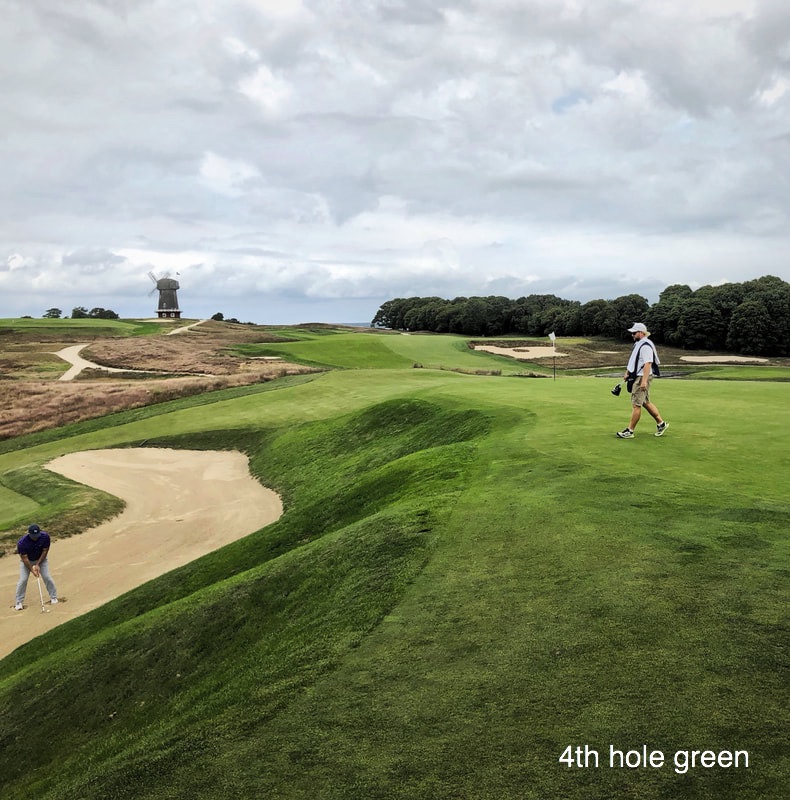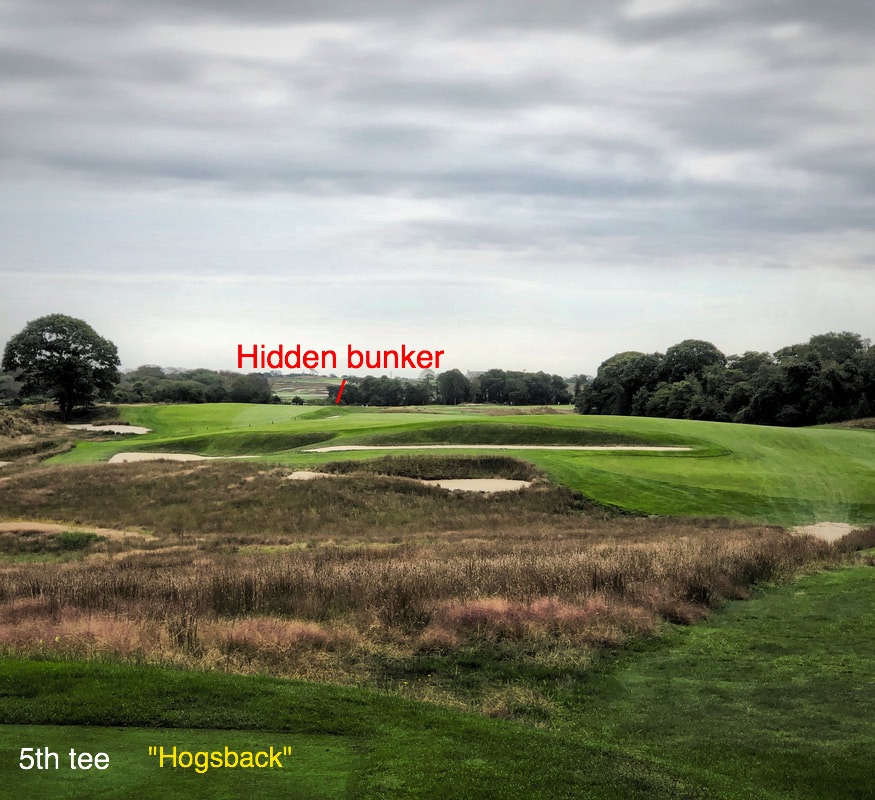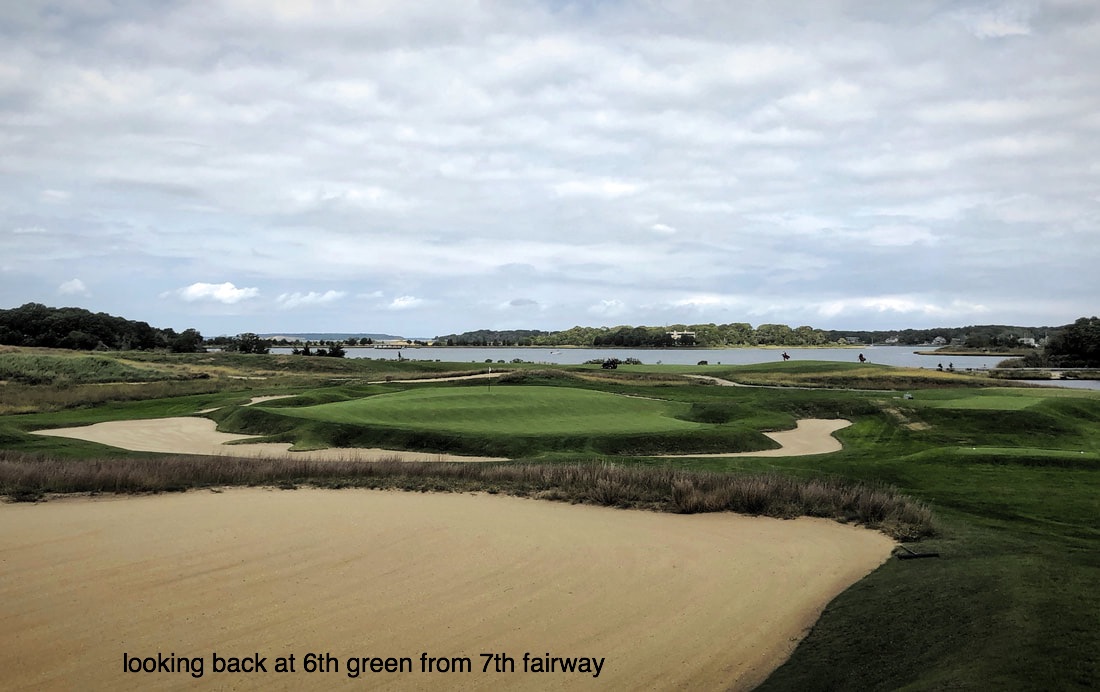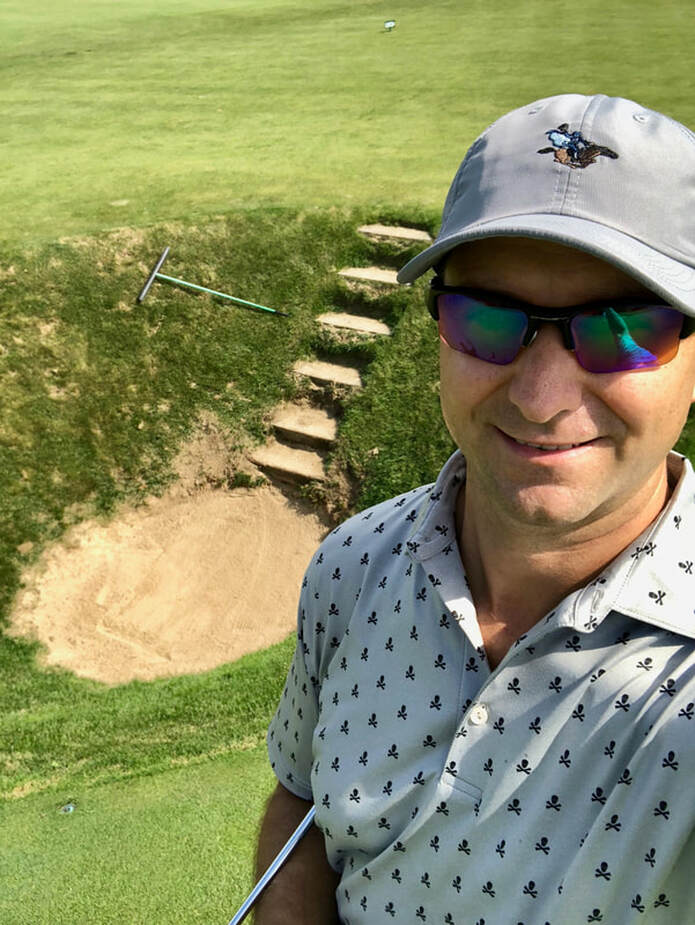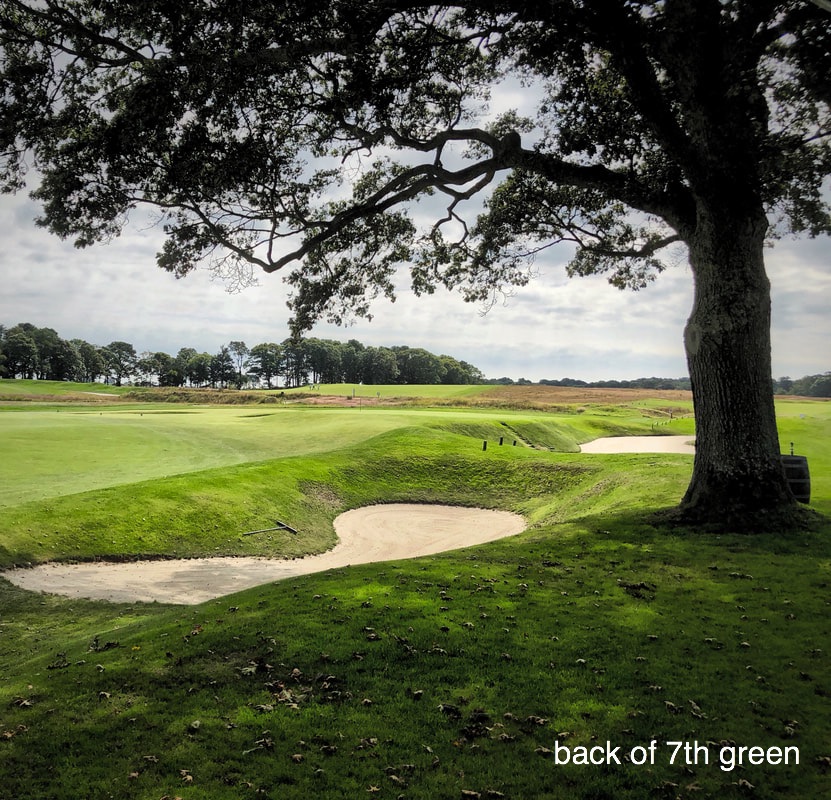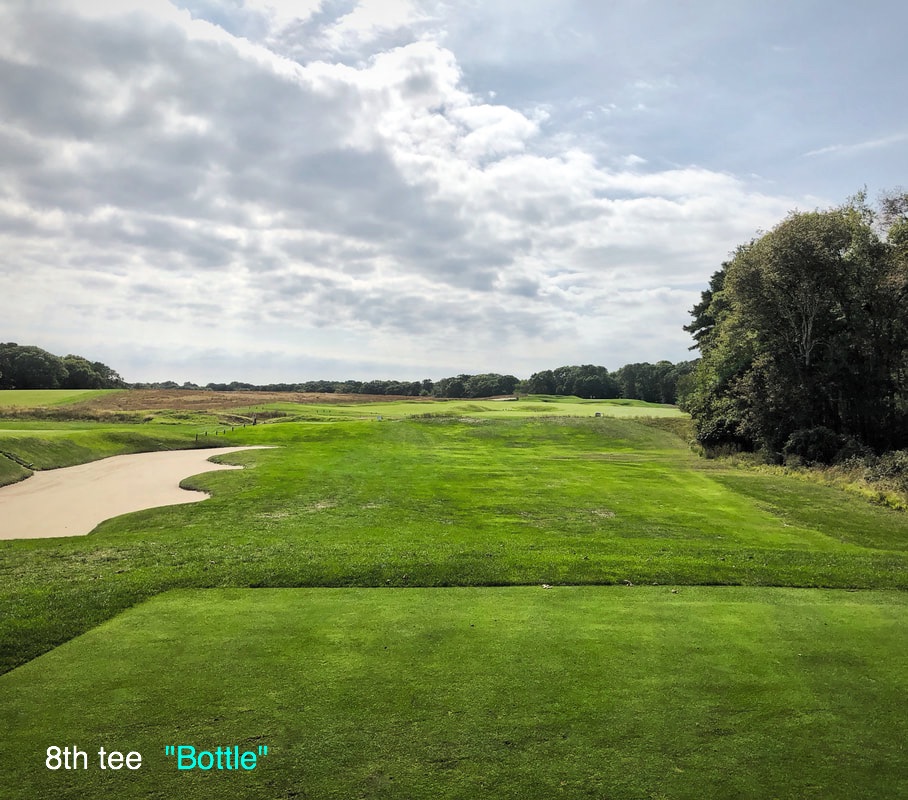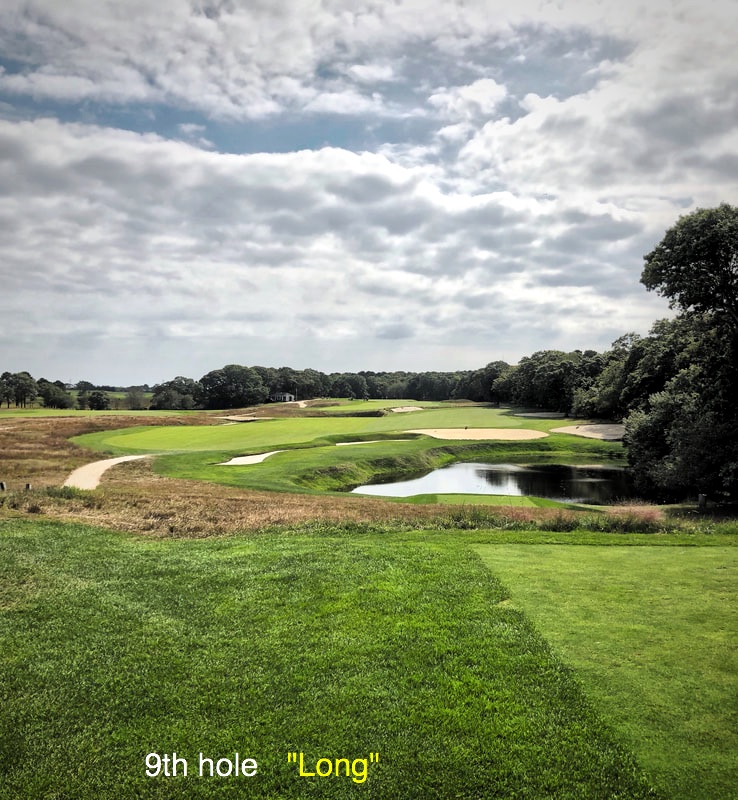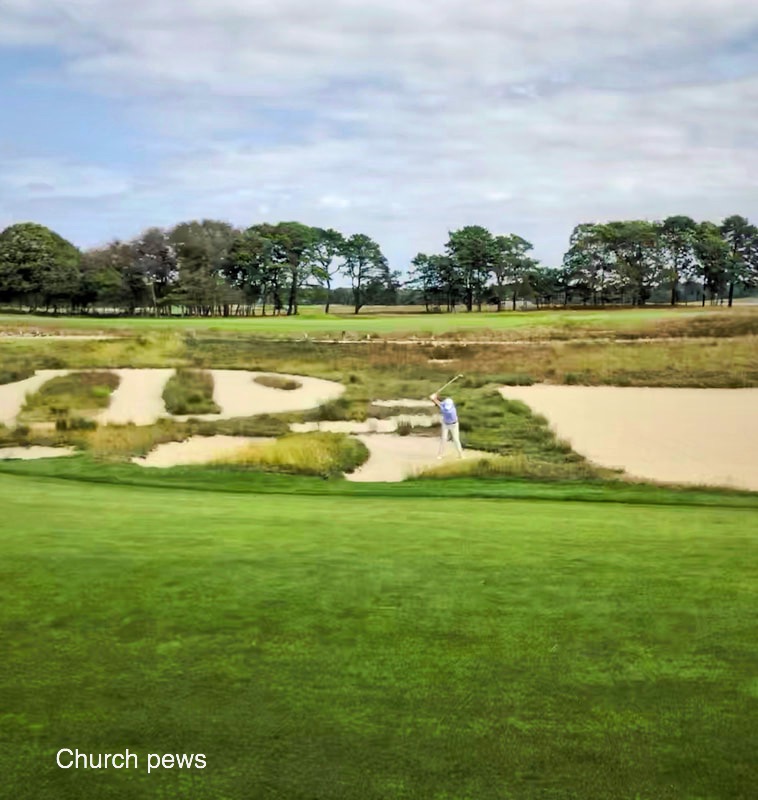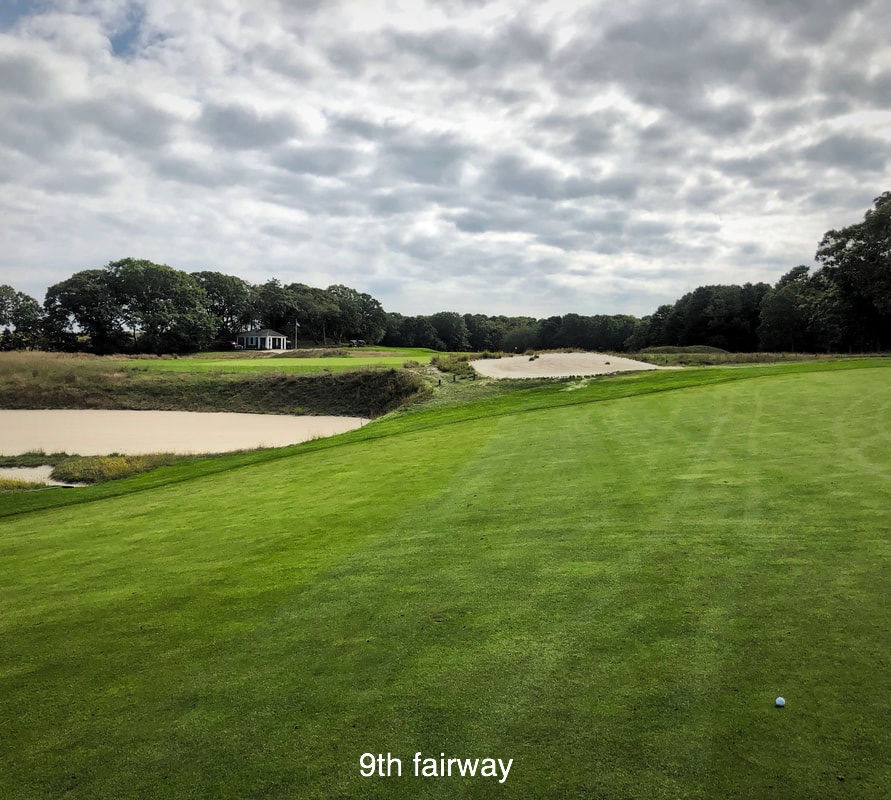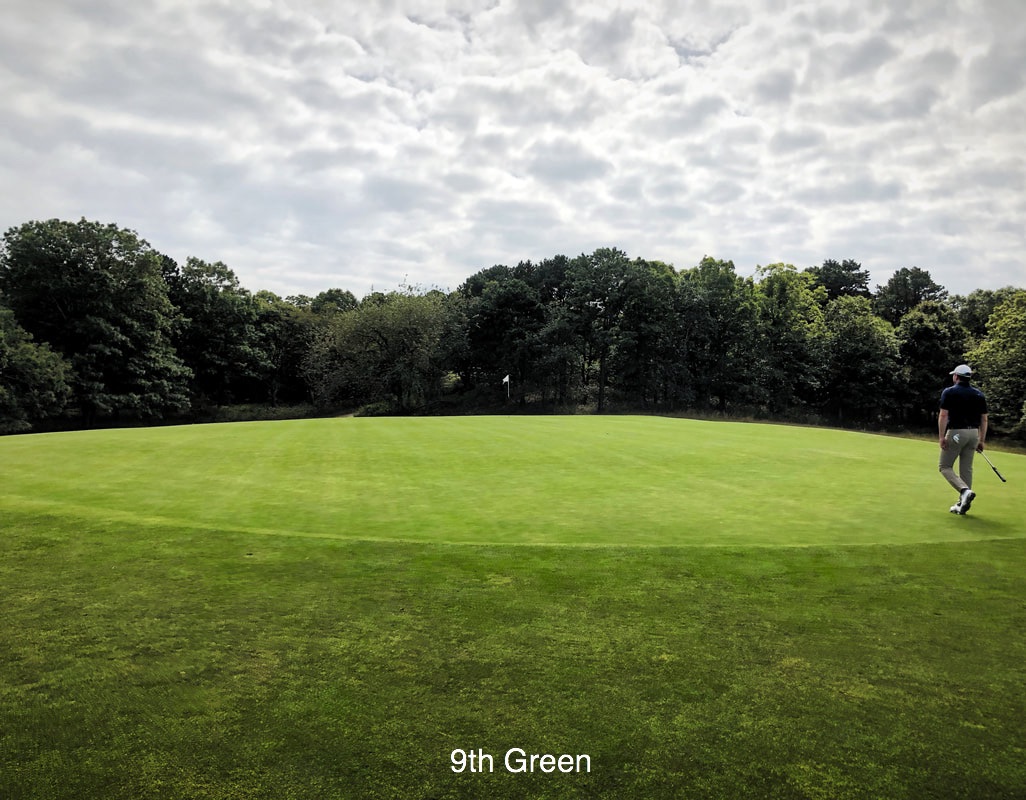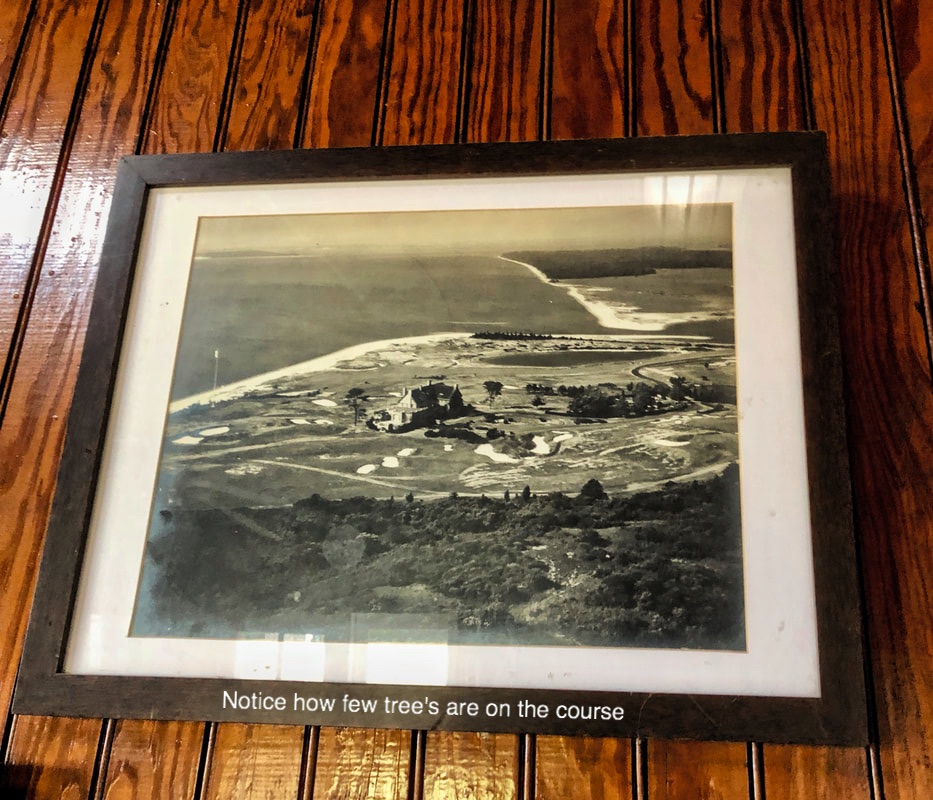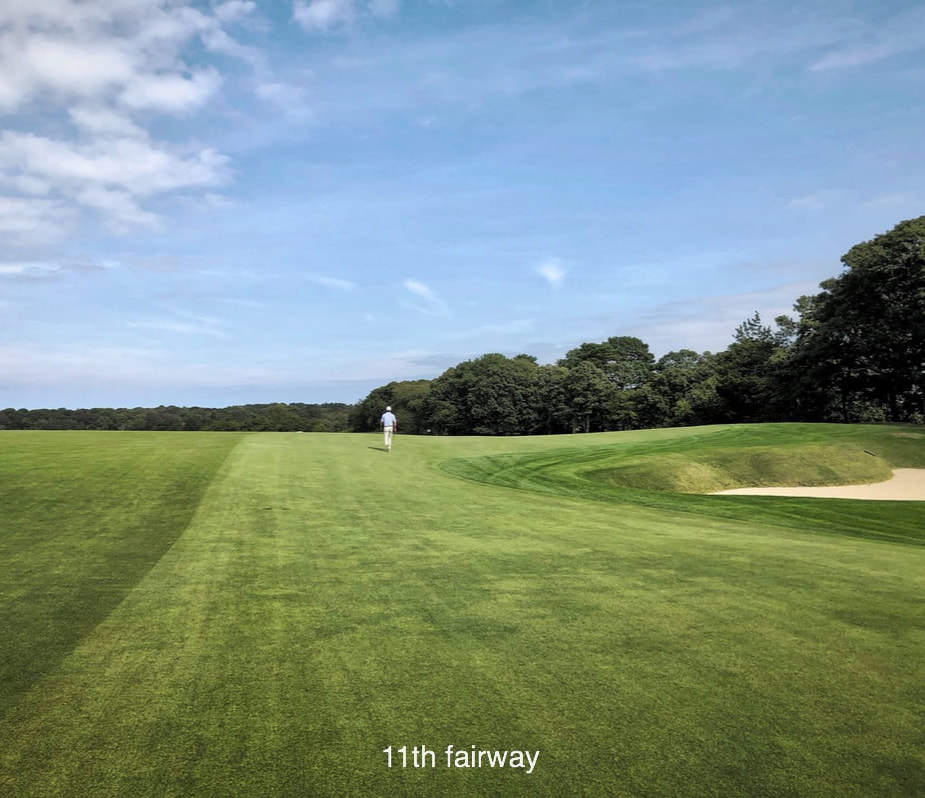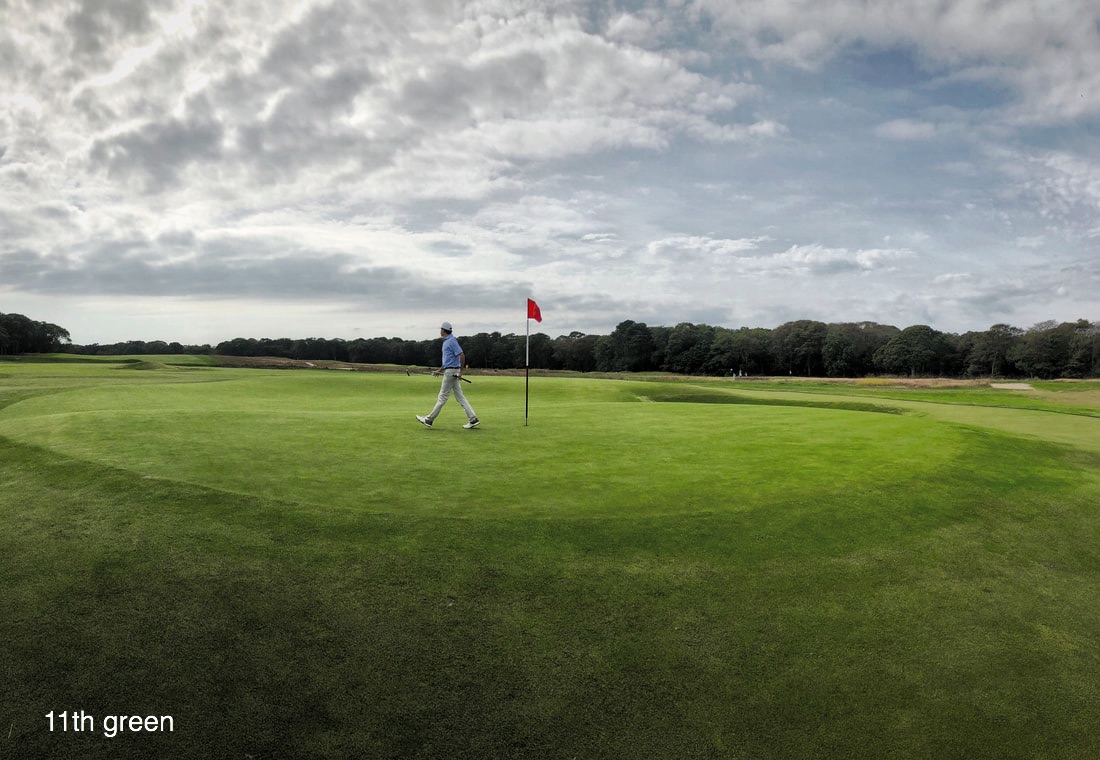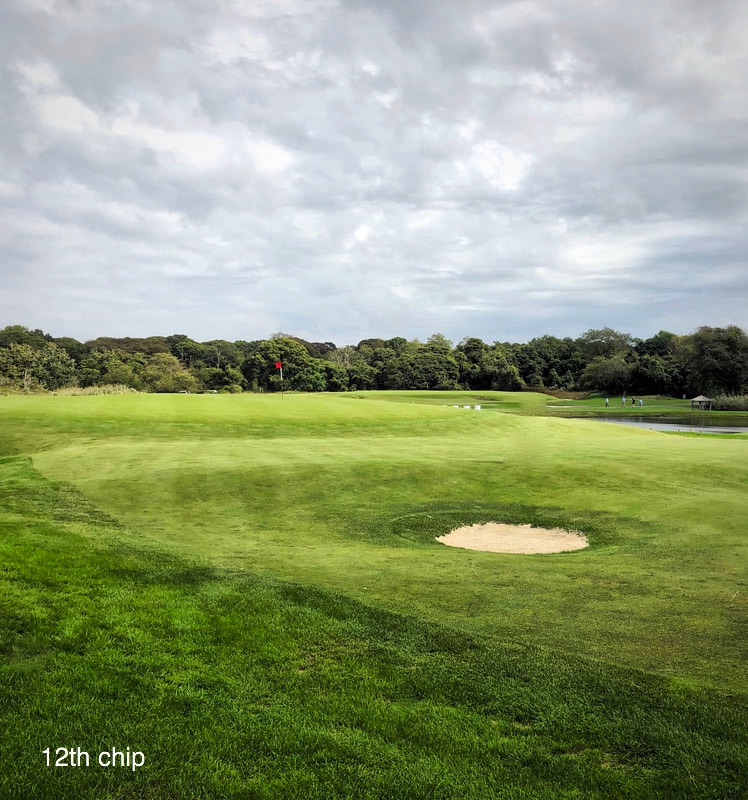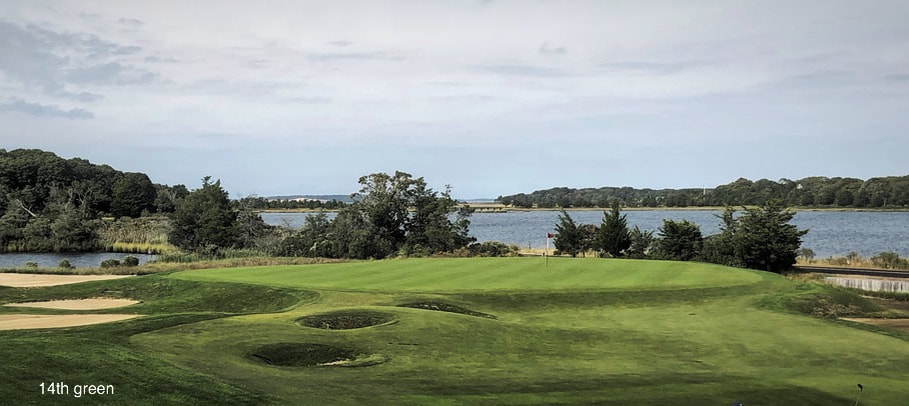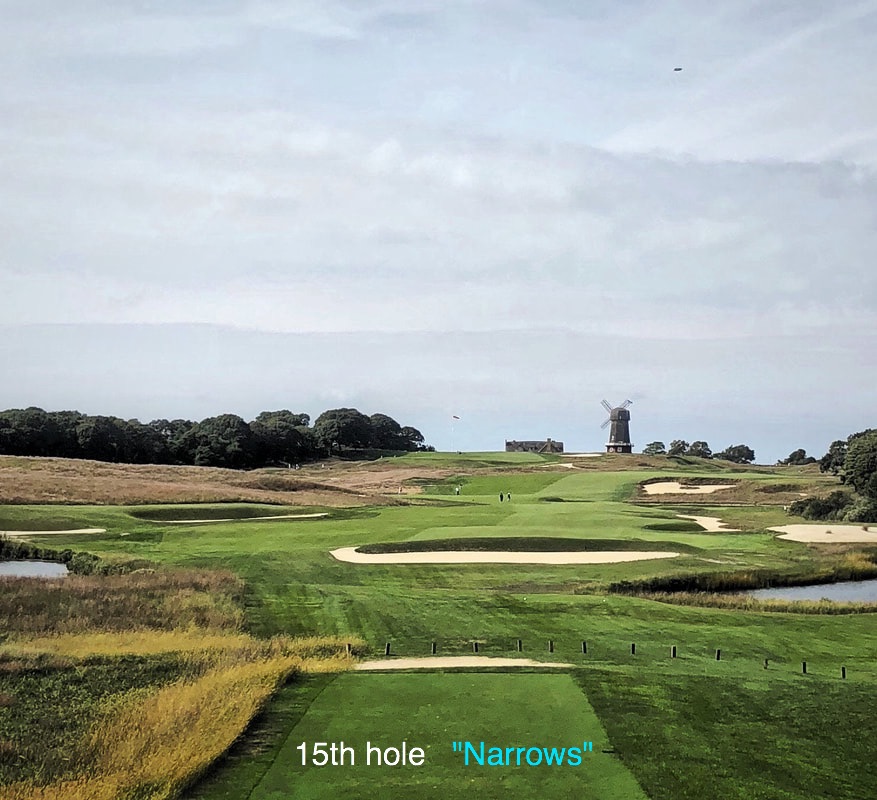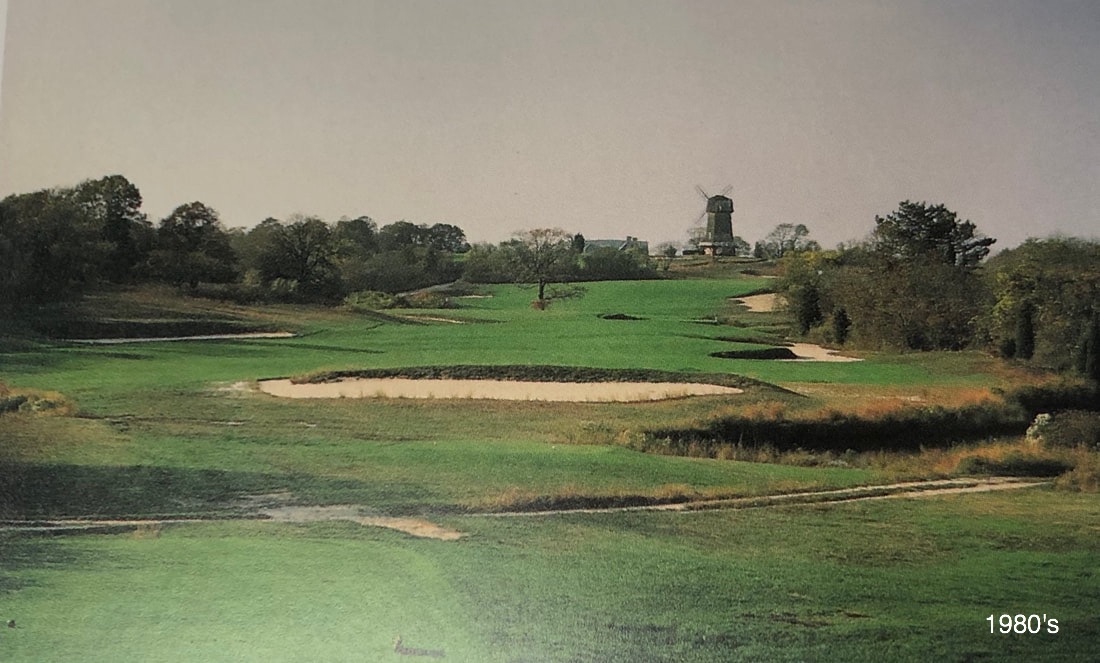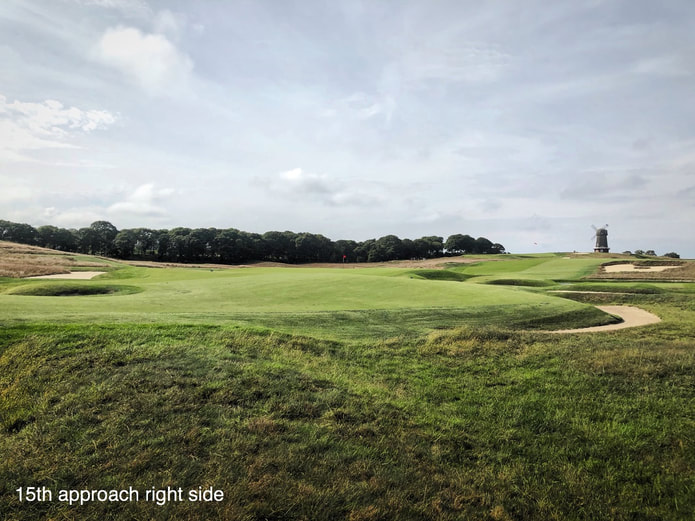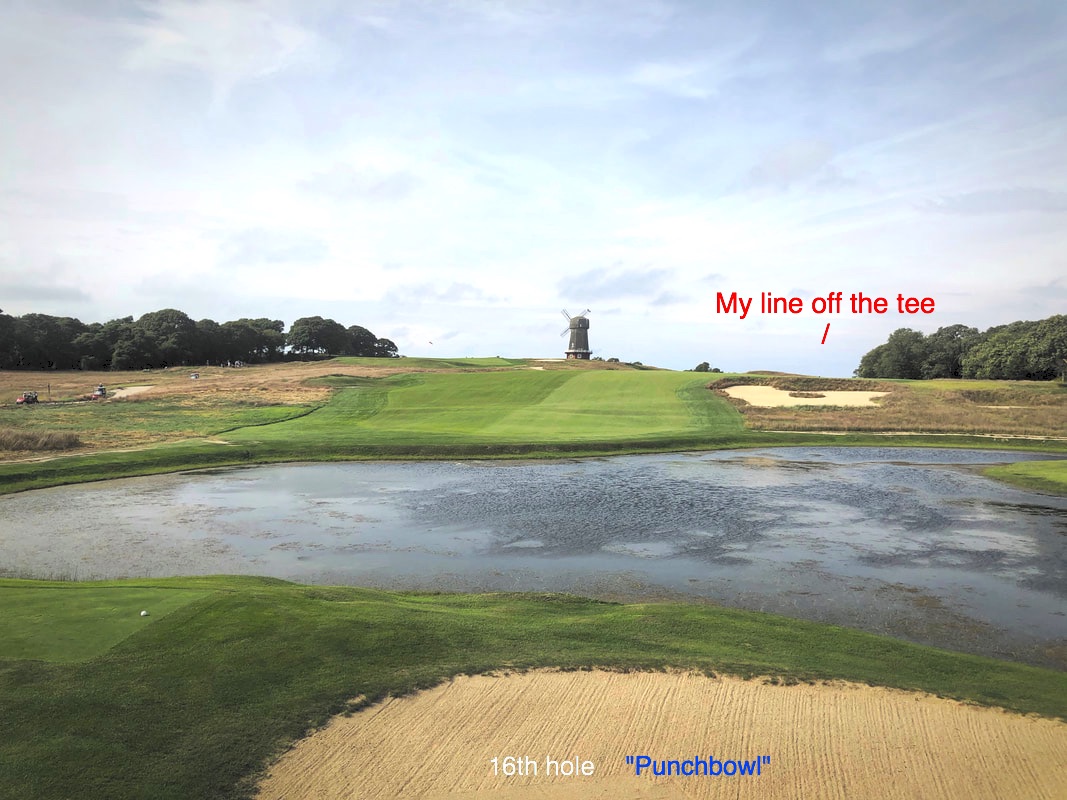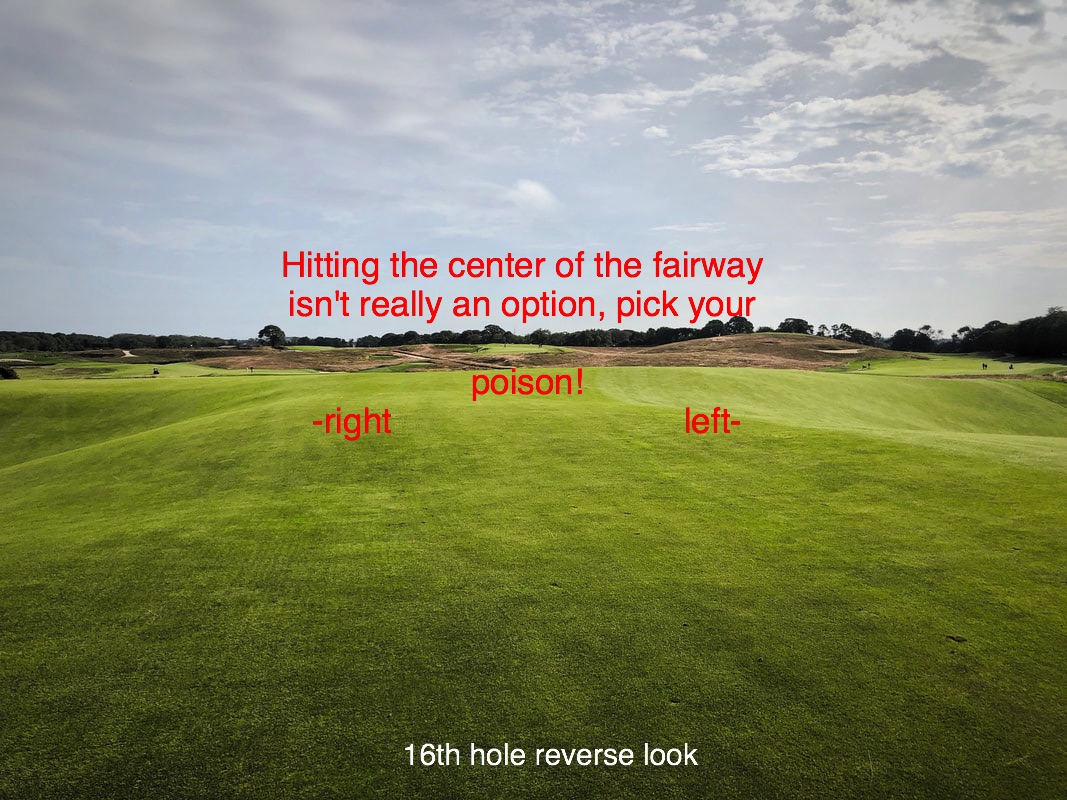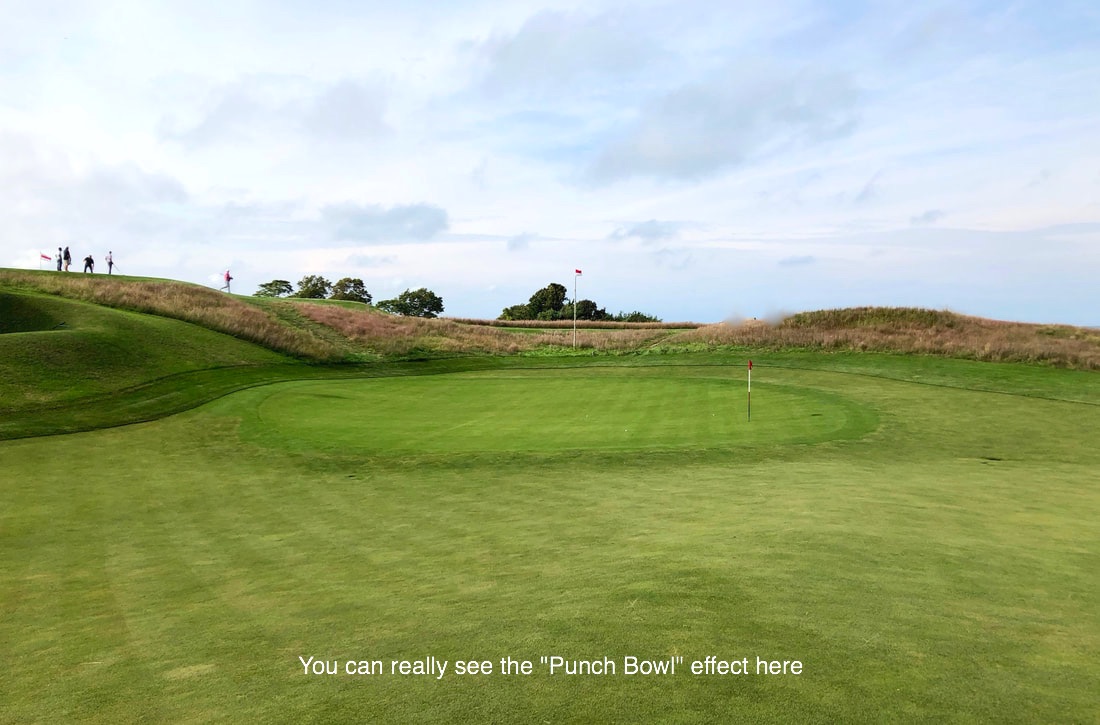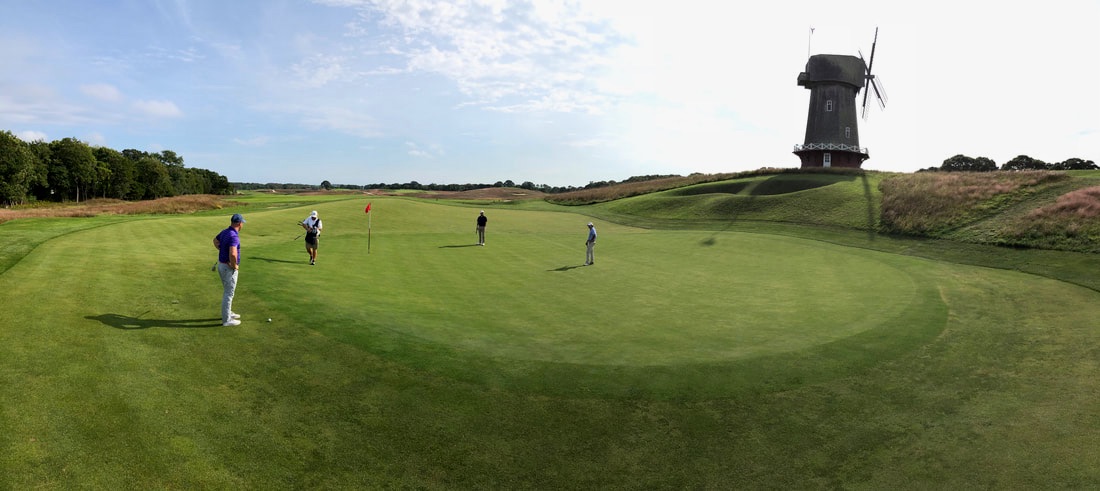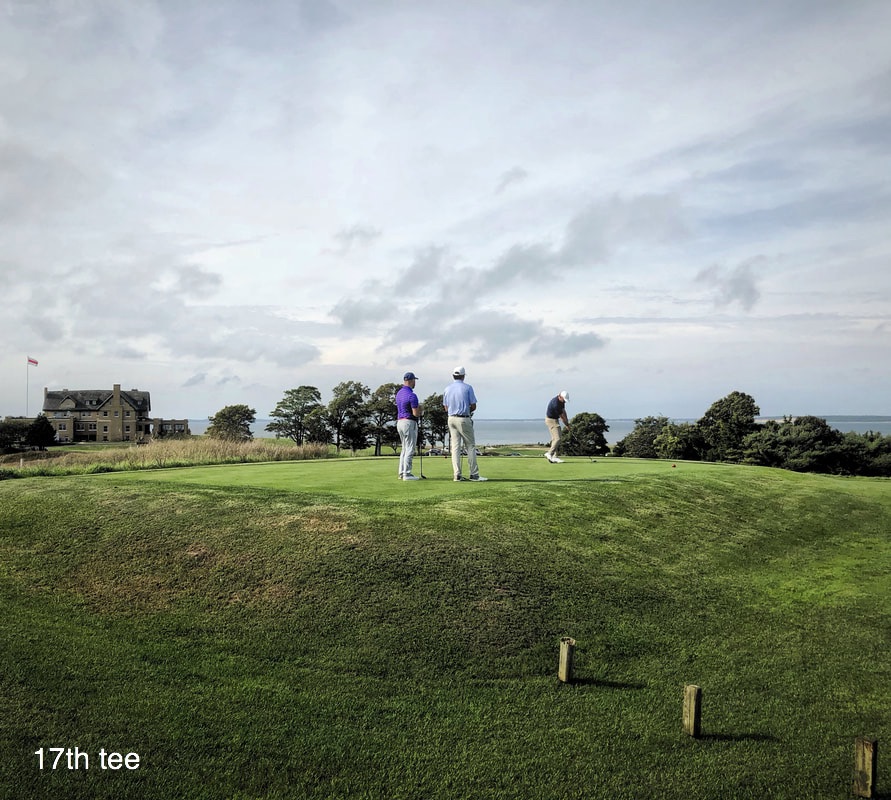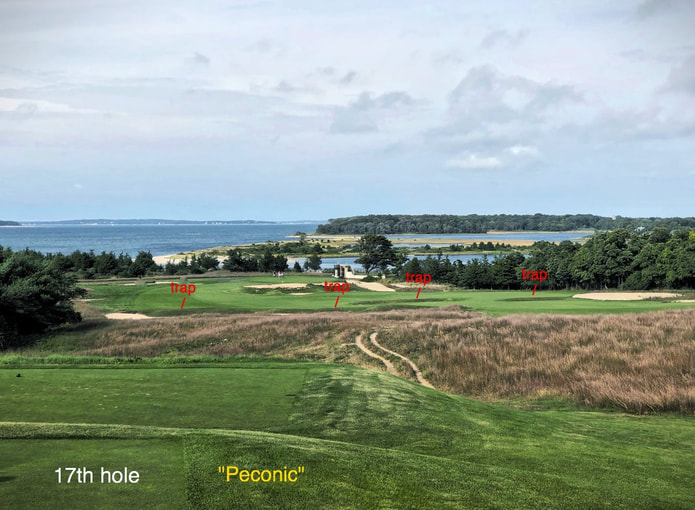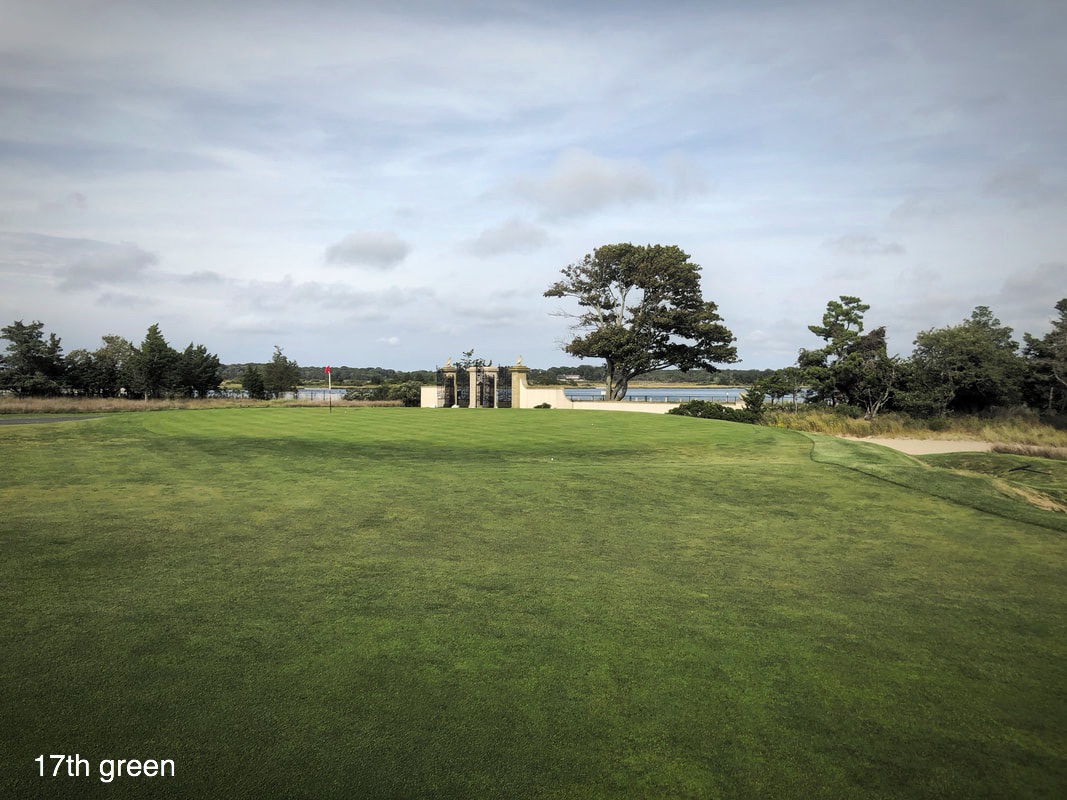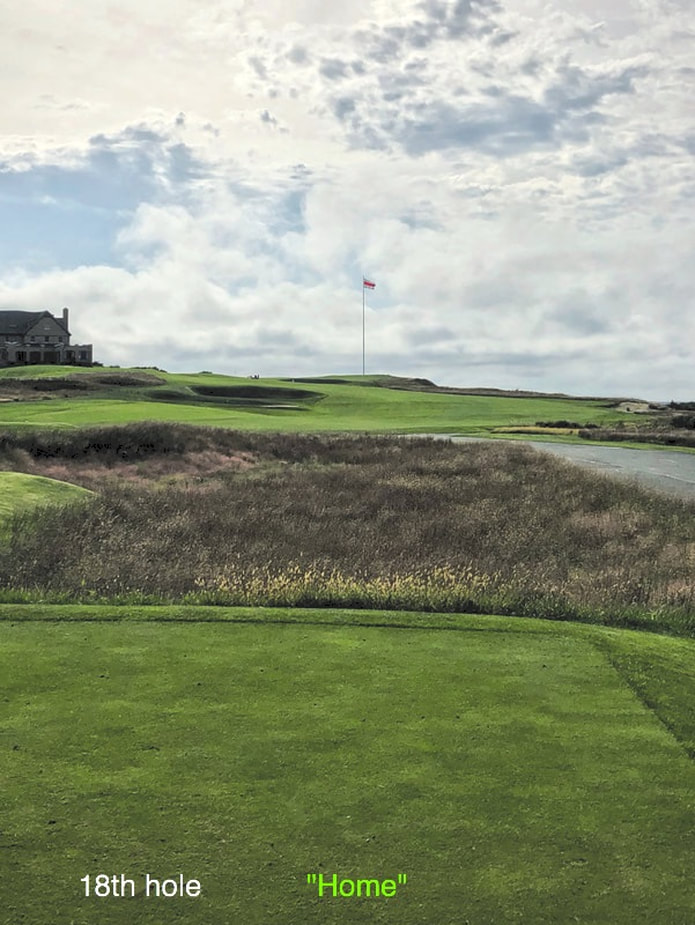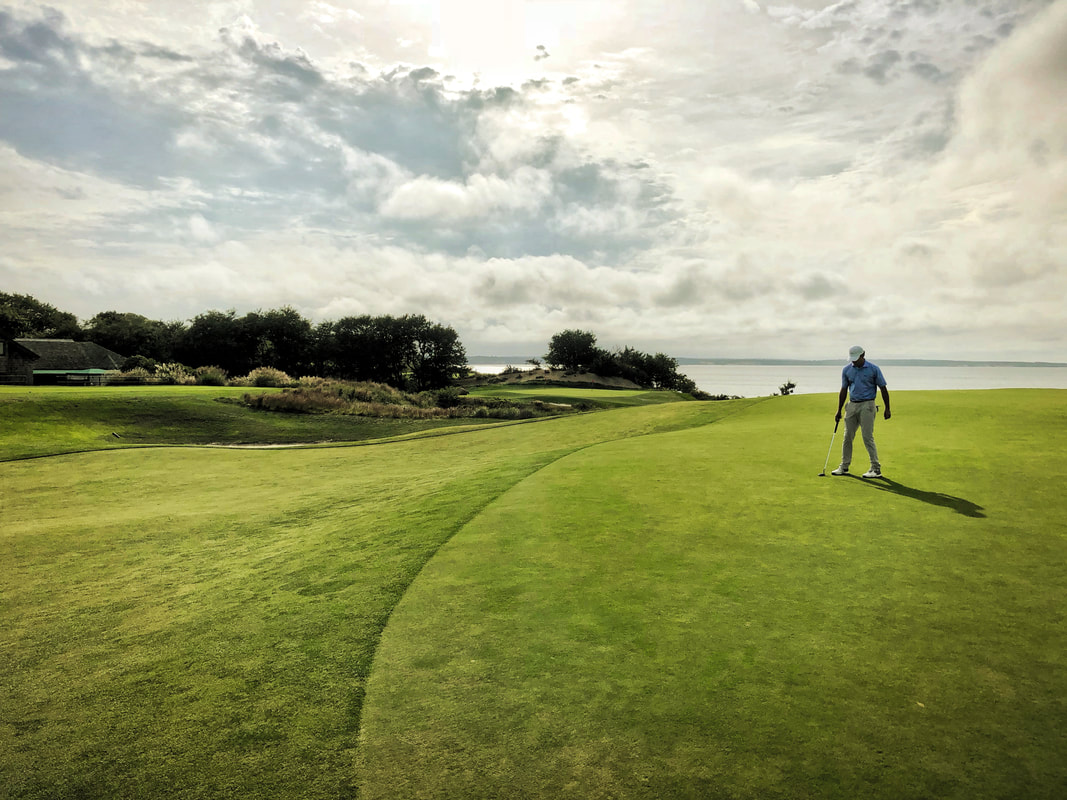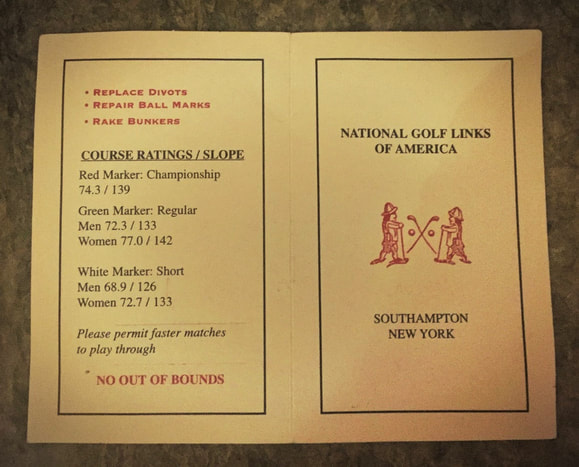|
When we think of famous golf courses most will conjure up images of Pebble Beach, Augusta National, and The Old Course at St. Andrews. As we venture further from these household names, the familiarity with many great courses falls off a cliff for the average golfer. Most have never even heard of The National Golf Links of America, but that doesn’t mean it’s not one of the best courses in the world. Consistently ranked in the top 20 worldwide, and top 10 in the USA, National Golf Links of America, or simply "National," as it is now more commonly referred to, located in Long Island, NY, somehow never gets the fanfare the other top courses get. This is probably due to the fact that no professional tournament has ever been held on its grounds, thus the lack of exposure. The grounds of National have been closed off to most, allowing me to show you one of the most unique, fun, ambitious, and storied courses in all of golf. The course was opened in 1908 by its founder/architect Charles Blair Macdonald, or C.B. as his friends called him. I could go on for days about the impact C.B. has had on the game of golf and design (credited as designing America's first 18-hole golf course, Chicago Golf Club) and after an in-person tour of National, his true genius became all too clear. Sometimes words are a poor substitute for describing someone who was much larger than life, just like his golf courses. To truly understand just what a remarkable golf course National really is, we must go back to the year 1906, when C.B. decided to build the course. Back then, America had no true championship course that could hold its own against those of the British Isles. Being an alumni of St. Andrews University and having none other than Old Tom Morris himself as his mentor, C.B. was no stranger to the fact that golf in America was nonexistent. C.B.'s connections in the world of American golf were vast (he was, after all, a founding member of the USGA), as were his "money" connections. He sent a letter to 60 men, all of whom were wealthy enough to afford the $1,000 initiation fee. His pitch to investors that sealed the deal was that after studying the finest holes in the British Isles and taking copious notes and map drawings, he was intent on building a single course which would incorporate the best features of all the top holes he had played. It would be the best of the best; the greatest golf course America had ever seen. Initial location contenders included Rhode Island but the remote location was a stumbling block and in stark contract to C.B's vision of attracting members from all over America. C.B.'s next thought was Long Island - the ground between Amagansett and Montauk. But the issue there was with the grass or lack thereof. This stretch of Long Island most resembled the wind swept dunes of Scotland - which was the appeal. Unfortunately, the cost of putting dirt on top of the sand to plant grass was going to bankrupt the project. So that shut down that location idea. But alas...a winner was found! Another location in Long Island, right next to Shinnecock Hills, proved to be the perfect spot. For the untrained eye, this wooded terrain, which was mostly swamp and bogs, would be deemed unsuitable for golf. C.B., on the other hand, painstakingly surveyed the land, walking every acre, and realized its potential. With far stretching views to the Peconic Bay and slightly more undulation than a Scottish course, C.B. also liked the fact that the location was tucked away from the world and all its distractions. “When playing golf you want to be alone with nature.” This was the place. This would become the National Golf Links of America. To help him with the project he enlisted the help of local surveyor, Seth Raynor. The two would work together on many future projects after forming a great friendship and admiration for each other, stemming from their work on National. Seth Raynor would go on to become one of the world's greatest golf architects, all the while using the same template holes that he learned and studied from C.B. As I got closer to the course entrance I could see a beautiful windmill dotting the landscape. A windy narrow road leads to a tall gated entrance.  As soon as you drive in you see the imposing clubhouse designed by Jarvis Hunt, one of National's founding members, directly in front of you. On the day I played almost no one else was at the course, making the experience just that much more special. Going inside and yelling "Hello! anyone home?!" in one of the most exclusive clubs in the world is pretty surreal. After discovering a private staircase leading to the downstairs basement with a sign saying "Founders Only," and not wanting to challenge the seriousness of the sign, I waited patiently until someone could direct me further. Eventually I was directed to the locker room downstairs which seemed stuck in a time-warp. Original in every way, the locker room was small by modern standards and reminiscent of a scene from a black and white 1940s film. After a quick change in the clubhouse it was a hop, skip and a jump to the pro shop just across the first tee. There I found a putting green and a fully stocked pro shop with a few choice products I just had to have: two hats embroidered with the National logo and a needlepoint putter cover. After making my purchases and a friendly hello with the staff, I headed to the range for a short warm up. The range sits along the edge of the Peconic Bay and leaves you with an isolated feel and nothing really to aim at other than the giant osprey nest way in the distance. But I wasn’t there for the range. This was National and I had read up on this historical course to the point where I felt It was already a part of me. A little history tidbit: before this was a driving range, it was an area consisting of 3 practice greens with replicas of the Eden hole (13th), the Short (6th) and the Redan (4th). I was greeted on the first tee by my caddie and the assistant pro who would be joining me for my round. No unaccompanied play is allowed at National. This is a great way to make sure the course is properly navigated and cared for. Most people tend to be on their best behavior when accompanied by a caddie and/or member, and considering we are playing on one of the true American treasures in golf, this rule makes perfect sense. Standing on the first tee as you overlook the clubhouse, the bay and the iconic windmill, you realize you're not at your local muni anymore. This is big boy golf and the first tee shot better find the fairway as the tall grass is penal and offers no escape. I decided to challenge the bunker dead center and try to reach the green. I didn’t quite make it and was left with a tough chip. After my birdie putt lipped out I walked away thinking about what could have been. The walk to the next tee was short lived because the 2nd tee was just off the back of the first green. The 2nd hole, which faces uphill directly towards the windmill, offers no look at the green. There is, however, a giant bunker running most of the left side of the fairway. The trap was modeled after the 3rd hole at Royal St George in Scotland. Unfortunately, this hole at Royal St George is no longer present, as it was converted to a par 3 years ago. Fortunately its genius has been persevered here at National. Most single digit handicap players will take a more risky line off the tee, aiming just to the right of the windmill and trying to drive over the bunker and knock it on the green. The windmill and its origins started way back when C.B. was still tweaking the course. Daniel Pomeroy, one of the founding members of National and the president of Conde Nast at the time, mentioned to him that a windmill at the highest point would be a nice addition to the course - mostly to hide the unsightly water tank that was currently there. C.B. took this suggestion to heart and decided to pursue the idea. While traveling in Europe he scoured around until he found the perfect windmill. Thrilled with his prized purchase, C.B. hired a crew to carefully dismantle the windmill and send it on over to America. Once reassembled on the course, C.B. asked Dan what he thought of the new windmill. He exclaimed that he loved it! He thought it was a great addition. C.B. nodded as if to say, "Great, I'm glad." After that he handed Dan the bill for the windmill! I’m sure from that point on the members at National were careful in their critique of the course. Although, in this instance, Daniel Pomeroy was spot-on; the windmill stands tall and proud, the true landmark and very soul of National.  After walking past the windmill that my ball so narrowly missed, I crested the hill to see one of the more beautiful views in golf. The high vista allows you to see more of the course than at any other point in the round. From this vantage-point it becomes clear why C.B. saw this land as the perfect location for his prized course. My tee shot on 2 reached the fringe of the green and after lagging my eagle putt just short, I was now -1 par. The 3rd hole is modeled after the Alps hole at Prestwick. There are so many standout holes at National which makes picking a favorite nearly impossible. The 3rd hole, however, is certainly on the short list. The green sits atop a tall hill below the fairway. The longer you drive the ball up the right side the better view you get into the green but make no mistake, you're going to be hitting blind on your second shot into the green no matter where you drive it. I landed dead center of the fairway and hit the ball exactly where my caddie told me and even still, I was left with a devilish downhill putt. Considering the circumstances, I was more than happy to walk away with par. The 4th hole, called the Redan, is a rendition of the par 3, 15th at North Berwick. The original designer is unknown but the greatness of this hole has been copied hundreds, if not thousands, of times. The basic concept is that the green is sloped from right to left with the right side being higher than the left. The pin is generally placed on the left which means the best way to attack the hole is with a draw that hits the right side and then funnels down to the hole. Over draw the ball and a bunker is waiting to swallow the ball, leaving a really tough up and down. I hit a perfect shot and ended up with a downhill putt only a few feet away. Another lip out and my frustration with my putter was growing. The 5th hole is one of the tougher driving holes with a deep bunker out of view from the tee at about 260 off the tee. Called "Hogs Back," the hole is modeled after the 12th hole at Sunningdale Old in Berkshire, England. The giant bunker dead center is a death sentence if you land in it. Fortunately for me, I carried the ball straight over but what waits on the other side is the hidden bunker... Of course with my accuracy I landed right in the middle of it! My second shot missed the green short left and a bogey was staring me in the face with a pin tucked just over the trap and only about 5 feet of green to work with. As you can see below, some of the holes at National allow you to use the ground as much as the arial attack. Luckily for me I was able to hit the flop shot of my life. The ball landed 4 feet from the hole and immediately stopped! This round was becoming so much fun and still being under par didn’t hurt either, until I missed the short comeback putt, leaving me at even par. What the golf Gods give they so quickly take away! The 6th is called "Short" - a par 3 that seems like a nice breather after such a tough stretch of holes. Surrounded by bunkers and a few humps and bumps on the green, Short is anything but easy. The green is essentially three greens in one so pick your line off the tee carefully. Ben Crenshaw is quoted as saying this is his favorite green complex on the course. "Short" may be its name but "deceptively diabolical" may be a more fitting description. The 7th hole, a par 5 called "St. Andrews," is a blind tee shot and is fashioned after the Road Hole at St. Andrews. The drive is relatively easy - just keep it off the right side as a long trap is waiting. But even that isn’t a death sentence. It’s the approach that could pose a problem: deciding whether to lay up or go for it in two. Similar to St. Andrews, the green here is fronted by a deep pot bunker. What the hole lacks is a road along the back side of the green. Instead, a deep set of bunkers waits to capture any miss-hit shots. It's important to remember that the golf holes at National are not simply a mirror image of the greatest holes that C.B. had compiled in his notes. Instead, the course tries, and succeeds, to capture the essence of what made those greatest holes so special. In fact, many of the holes at National that follow this template are today considered better than the original holes which inspired them. Having played a few of the "original" holes abroad myself, I can certainly attest to the praise these new holes receive. And let's not forget that along with these "best of the best," there are also C.B. originals at National. Each and every hole on the course has the bones of the ancients running within them. The green is abruptly raised about 2 feet on the front collar, making chipping a very delicate matter that only the steadiest of nerves can navigate. I managed to hit a salty little bump and run to only a few feet from the stick and then sunk my birdie, getting me back to -1 for the round! The 8th hole is called "Bottle" because of its bottleneck effect on the tee shot. Two approaches are available to the player: either heading up the left where the view to the green is better or take the right side that is much wider off the tee but offers little in the way of seeing the green on your approach. The hole design comes from Sunningdale Country Club where C.B. first saw this design employed. Shrubland Road bisects the course here at the 8th and again at the 11th. The club does a great job of camouflaging the road with tall mounding in front of it. This means you never really see any cars until you are literally on the road. This is another example of a course that understands the framing of holes and just how distracting cars can be if not dealt with correctly. Whichever side of the fairway you choose to play your tee shot from the hole will still present quite the uphill approach challenge. A par here and you will be more than happy. Caution was taken with my birdie putt because the pin was in a precarious position on the back edge of the green and I didn't want to let the putt get away from me resulting in a tap in par. The 9th hole is the longest of the par 5s. It may seem short by today’s standards but what it lacks in distance it makes up for in required precision. Off the tee, the shot needs to favor the right side because the entire left side is a pit of misery, often referred to as "hell's half acre," with deep church-pew bunkers and ragged grasses strewn everywhere. I hit the ball to the right, leaving me with a longer approach shot into this deceptively guarded pin. At first glance this seemed like a simple approach, thinking I could just hit a long club and knock it on the green in 2. Not so. The unforeseen problem is that the entire back of the green falls off a cliff into a horseshoe-type sand trap. The green has a perfect crown at the back half, ready to grab any ball hit one foot too far, leaving a very tough chip. Birdie here is not always as easy as it looks. The course layout is a classic "out and back," meaning the furthest point away from the first tee is the 9th green then reversing course and heading back to the clubhouse. Of course a small halfway house is situated just off the 10th tee for all your refueling needs. Stocked with all the standard staples of food and also a pretty cool arieal photo of the course from years ago. After a quick bite and a perfect drive down the center, I was headed back to the clubhouse. But there was still a lot of golf left! As you walk down the 10th, aptly named “Shinnecock“ - you can see the clubhouse and a few holes of the famed Shinnecock National through the trees. This sight reminds you of what sacred grounds you are walking on. These are the roots of American golf and without the men and women who loved this game enough to grow the game and preserve it, all of this might be lost - just like so many other classic designs. This is our St. Andrews! The 10th hole approach is sweet! 150-200 yards to a circular shaped green that is massive. The surrounding hills that wrap around give it a stadium feeling and frame the picture perfectly. One feature the course possessed was that of “complete capture” - every hole completely captured my attention. How many times do you play a great hole only to see power lines, or some other obstruction, in the distance that draws your attention away from the hole and its design? My approach was dead on target and my 6 foot putt for birdie hit the bottom of the cup with confidence, getting me to -2 for the round. I was on top of my game and what a course to have my skills peaking! The 11th hole is a blind tee shot that requires you steer clear of the left side, as a hidden bunker awaits you! Once you’ve accomplish that, the real fun begins. The hole is named after its green, the Double Plateau. A diabolical design which essentially separates the green into three levels: two higher plateaus with a lower plateau separating them. We had a back right plateau pin and I missed a hair right, leaving me with a tough chip. I landed my chip within about 12 feet but lipped it out for a bogey 5. Even with my skills at full operation, the course was putting me to a stern challenge. The 12th is a shorter par 4 that offers a tough drive with a truly intimidating visual. Sand traps straight away and trouble to the right tighten the muscles a bit. Once in the fairway you can see this visual was just for effect and in actuality there is plenty of space to hit your tee shot. A little deceptive camouflage goes a long way in golf. The approach is to a raised back-to-front tilted green with steep crowns on the edges. This essentially means the green is extremely small in size. I was able to just stay on the green and made a really good roll at birdie. That stellar roll paid off with the ball rolling directly into the hole, getting me back to -2 par! The 13th is a classic template hole that C.B. used in all his designs. The “Eden” hole is fashioned after the 12th at St Andrews. This is one case where I prefer the original, as the backdrop of the sea at St. Andrews is other worldly. However, the 13th at National is no slouch. A huge pot bunker fronting the green must be avoided at all costs. My tee shot was struck so pure that the moment it left my club I knew it was going in. Instead, it hit the flagstick and bounced about six feet away. With a slippery downhiller, I stepped in with confidence and drained it. A hole in one would have been insane but so is -3 under par at National!! The tee box for the 14th is just to the right of the 13th green. Yup- this is another feature I love! This makes walking the course such a breeze. This hole offers you multiple options off the tee. The Cape hole is a perfect example of how a short hole can offer just as much trouble as a long hole. I hit my ball into the sand on my tee shot, leaving me with a challenging shot to the green which I failed miserably at. Landing about 40 yards short I made another poor shot with my wedge, leaving me around 30 feet for par. As the putt rolled toward the cup I could feel the hole pulling it close, like a magnet to metal, and in a flash it was gone and in the hole!! 15 is a wonderful par 4. Your best approach is a tee shot down the left side of the fairway which has a hidden little speed slot - fortunately this is exactly where I hit it. The devilish green is a steep back-to-front design, making club selection and your ability to stay under the hole a priority of the utmost importance. During the 70s and 80s the course was overgrown with trees, as you can see in the picture below. It's nice to see the present condition of the course, back to its original style with a open links design. No more trees! C.B. was clear on his intent to use the wind as a factor on the course. Never does a player face the same direction, hole after hole. Instead, the course zig zags all over the property, challenging the player's ability to navigate different conditions. C.B. is quoted as saying "Trees are beautiful, just not on a golf course." Studying the courses of the British Isles certainly influenced C.B.'s view on trees or disdain for them. I, myself, share C.B's preference for less trees and more wind and think the restoring of National to its original state is a step in the right direction. This little speed slot probably gave me an extra few yards, not to mention a perfect look into this green. My caddy told me the pin was in too difficult a position to attack and the smart play would be short and left of the pin. As I stood there looking at the shot, a feeling of pure connection to the course and the hole came over me. I told the caddy I was going directly at the pin and after a perfectly struck 8 iron, my ball was less than three feet from the stick! After my tap in birdie I was suddenly -4 for the day. The game was on! The 16th, nicknamed the “punch bowl," became one of my favorite holes in golf right after I played it. The hole offers one of the strongest visuals off the tee. The windmill standing tall in the distance and a huge bunker covers the right side of the fairway, but looks are deceiving. The carry over it isn’t that bad and most will clear its capture. This, however, doesn’t mean the rest of the hole is easy. What you can’t see off the tee is the fairway landing area. The fairway is a giant crown dead center with 30 foot drop offs on both sides. Hitting the center is not really an option as it’s only a few yards wide. I decided to play down the right side and was left with a blind approach to a punch bowl green. The pin was down toward the bottom of the bowl so in theory any shot hit anywhere on the green should funnel down to the bottom. Unfortunately, my shot hit and stuck on the hill, leaving me a sliding putt from left to right that just missed for birdie. The hole from tee to green offers so many options that one can’t convey just how special this hole is. the 17th tee sits high on the hill, overlooking the clubhouse and Peconic Bay. The hole is considered by many to be one of the finest example of strategic design. Multiple options off the tee lead to one of the more pressure packed tee shots in golf. The tee shot can be tricky depending on the wind. Down wind and the traps straight away are in play. Hitting down the left side is the only way to get a look at the green for your approach. This is also the riskiest route as it's the narrowest landing area. I took a 3 wood and just tried to find the middle, which I did. The second shot, however, is quite a challenge as the bunkers dead center are actually raised severely from the fairway, resulting in a blind approach for anyone not on the left side. The green is well protected and similar to the 17th at St. Andrews - there is a road just over the back of the green. Fortunately, a bunker surrounding the back means the road rarely, if ever, comes into play. I took a common par after playing to the middle of the green and two putting. The 18th is the last chance for glory and for those not hitting the ball well, a bunker protecting the left side becomes a bear to carry. Fortunately for me, I was in great form so after a blistering tee shot up the left and over the bunker, I was looking at 240 yards to the pin and maybe an eagle putt. My second shot came up a few yards short and after a less than stellar chip I missed my birdie but made a par. With a handshake and a tip of my cap to my playing partners, I began to reflect on playing the course. The round was fun, thrilling, and overall just a blast. A mix of both unique and challenging shots lead to one of my best scores and best times ever on a golf course. Once the round was over I headed back to the clubhouse to change and have a quick look around inside. The eerie sound of stillness was broken only by the creaking floorboards. The age of these rooms was evident. I wandered around in awe - the clubhouse had a very stoic feel, with small busts of the founding members lining the hallways. C.B.'s presence not only filled the halls but there was also a full size statue of him in the library. The elegance and charm of this club cannot be understated. Take a look at this picture of the bar and its "standing only" policy. It doesn’t get anymore old school than that. After exploring the clubhouse and soaking in as much of the experience as possible, it was time to head home. Leaving the grounds I felt my soul ache for more of this wonderful place. But alas, I was left with only my memories and the knowledge that I took on one of the greatest courses in American golf and held my own with a 68. But the score isn't what I'll remember about my day at National. The course left a lasting impression on me that was of far greater impact than any score. C.B. felt score was a small part of the game and "The man who regards golf as a matter of ‘card and pencil’ is not a golfer at all, for he has lost his soul in arithmetic, whereas the true golfer puts his soul into the game for the love of it, and not because it amounts to a mere matter of mathematics as he winds his way back to the club-house.” Well said C.B. - well said... C.B. Macdonald stated that “a first-class course can only be made in time, It must develop.” C.B. would tweak the course for the rest of his life, altering every hole somewhat over the next 30 years. To this dedicated ambassador of the game I say thank you. Your creativity and determination will never go unappreciated by this golfer and with any luck more people will get to experience this truly unique and masterfully designed course that changed the face of American golf forever. After shooting such a great round I felt like I could walk on water - like this little guy above! Maybe it's because my Truelinkswear shoes are light as a feather and comfy as could be!
0 Comments
|
I started this blog after years of traveling and growing frustrated with the limited amount of information about the courses I wanted to play. I wanted to see all 18 holes in pictures before I played the course and to learn a little about the area surrounding the course. I wanted a complete immersive look into where I was going to play. Since no one else was doing this I decided to do it myself. The courses I choose for this blog are the ones that stood out among all the thousands of courses I have played. Not all will be considered architectural masterpieces but they all offer something unique to the golfing world. I hope this blog inspires you to get out and see the world and maybe sneak in a round or two along the way! 
Categories
All
|
Proudly powered by Weebly




